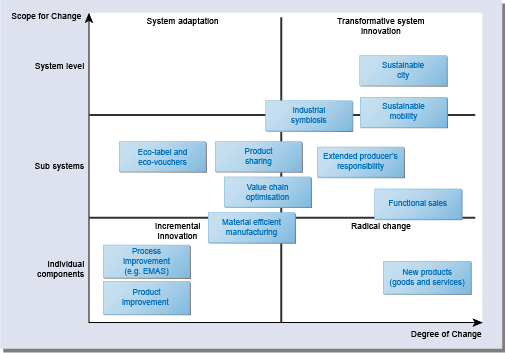1.13 System eco-innovation
As mentioned earlier, much of the innovation literature is focused on individual elements, such as technology or an idea. System eco-innovation is an attempt to move away from this more narrow focus to engage in discussion about system-level change. As you have already seen, quite what is understood as the ‘system’ is dependent on who is describing the system and the boundaries being drawn. In this sense, the ‘system’ may be the individual organisation (and all its component elements) or the organisation as part of a supply chain and particular part of the economy.
Reading 5 EIO, 2013, pp. 36–8
Approximate reading time: 10 minutes
Read Section 4.3 ‘System eco-innovation: measuring up to the challenge’ on pages 36–8 of the EIO’s annual report ‘Europe in Transition: Paving the Way to a Green Economy through Eco-innovation [Tip: hold Ctrl and click a link to open it in a new tab. (Hide tip)] ’ (EIO, 2013).
Activity 13 System eco-innovation
Briefly define system eco-innovation and summarise the main points made in the reading.
Provide your answer...
Discussion
System eco-innovation is defined as a ‘series of connected innovations that improve or create new systems delivering desired functions while reducing environmental impact’ (EIO, 2013, p. 36).
As set out in the accompanying text, notably, this definition refers to the whole system rather than a focus on its individual components or elements.
The main points discussed in this section include the following:
- Use of systems concepts and linking these to system level eco-innovation.
- Applicability of the notion to a range of systems of different scales.
- System eco-innovation can vary from system level adaptation to a more radical transformative system innovation, based on scope of the innovation and degree of implemented change. System innovation occurs at subsystem and system level, but can be incremental and lead to adaptation of an existing system. Conversely, transformative system eco-innovation results from more radical redesign of existing systems resulting in a transformative change in the process, product, service or idea.
- System eco-innovation is challenging and focuses on identifying the root causes of systemic problems to enable shifts to more sustainable forms.
- Individual elements of innovation, while important, are unlikely to be taken up unless considered as part of the wider system.
- System eco-innovation sees barriers to eco-innovation as part of the system and aims to address these as part of the innovation process.
The reading also contains an interesting graphical representation of innovation, an interpretation of which is shown in Figure 6.

While some of the detail is less important, the figure shows innovation according to the degree of change (from incremental to radical) and the scope of change (from individual elements, such as a product, through to system level). You will notice that the figure does not explicitly refer to ‘disruptive’ innovation.
The lower left quadrant is where incremental innovation is located – essentially improving existing components, processes or products. An example would be improving the manufacturing process of a light bulb or reducing its toxic components. Directly above this, innovations in the subsystem encompass some aspects of system, but not all. An example might be innovations in the supply chain of the materials obtained for manufacturing the light bulb. Or innovations in the lighting sector more widely, such as introducing LEDs into domestic markets. The upper left quadrant is when innovations occur at societal level – arguably, the adoption of CFLs in the EU would be situated here.
The lower right quadrant is where radical changes in individual components, processes or ideas are situated. An example might be a solar panel. The middle right quadrant corresponds to subsystem innovations, such as a manufacturer improving the environmental aspects of the supply chain of its solar panel components and, more radically, disposal options, including buy-back. The upper right quadrant is the arena for locating transformative system-level eco-innovation. This might include rethinking the way domestic energy is generated, leading to system-level transformations in domestic energy production and use.
As noted earlier, where a particular product, process or idea is located on this grid is dependent on the perspective of the person. If you consider a CFL light bulb to be a radical lighting technology, you might move it to the right-hand quadrants. If you see it as just one small improvement, you might locate it on the left-hand side of the graphic.
It is also important to be aware that this graphic assumes innovations of any type are essentially positive. It does not provide room for locating negative innovations that could engender system-level transformation but with highly negative environmental impacts. Arguably, the invention of the internal combustion engine and its ubiquitous adoption for personal transport in the twentieth century has led to a wide range of environmental impacts associated with resource use and pollution. On the basis of this graphic, would we be justified in placing the engine, the car and road transport systems on the right-hand side?
